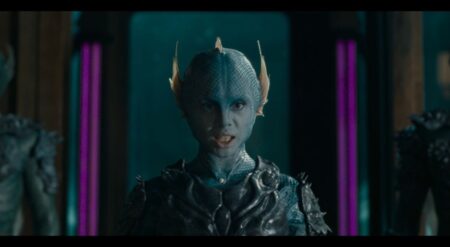Strange New Worlds continues to prove why it stands as one of the strongest modern entries in Star Trek. With Strange New Worlds Season 3, the series once again delivers a sharp balance of character-driven storytelling, high-concept science fiction, and a real understanding of what makes Trek resonate across generations. Even three seasons in, the show isn’t losing momentum. If anything, it’s leaning further into what it does best: blending emotional stakes, wild genre swings, and self-aware nods to the franchise’s long history.
Plenty of modern Trek has wrestled with how to balance nostalgia with innovation, even when returning to iconic characters like Picard. Strange New Worlds handles that challenge better than most. The show acknowledges its place in the timeline, references the original series directly (sometimes hilariously), and still isn’t afraid to reinterpret material through a modern lens.
Whether it’s reimagining once-goofy villains like the Gorn as terrifying existential threats or leaning into full genre swings with cosmic horror, zombie survival, or meta-Hollywood holodeck parodies, Strange New Worlds Season 3 confidently walks the line between respect for the source material and full creative freedom.
The range of tones the show pulls off episode to episode is one of the reasons Strange New Worlds has settled into such a distinct identity within modern Trek. One episode delivers tense sci-fi rescue operations. Another leans fully into surreal murder mystery holodeck simulations.
Genre diversity is one of Strange New Worlds Season 3’s greatest strengths.

And then it can pivot straight into unsettling horror territory, all while maintaining a clear emotional throughline for its characters. The shifts never feel like gimmicks. Instead, they give the crew new angles to explore their individual conflicts, often using genre not just for variety, but to pull something more personal from the characters involved.
At the core of those stories remains one of Trek’s most timeless themes: the monster within. Strange New Worlds Season 3 continues to explore how much of the danger in space mirrors the struggles inside each crew member. From Gorn infections to unresolved trauma, ambition, guilt, and loss, each storyline continually circles back to how the characters grapple with their limitations. The show may be introducing new cosmic horrors and massive threats, but the most lasting conflicts always boil down to these individual emotional battles.
That kind of weight works largely because of how strong the cast continues to be. Ethan Peck brings real complexity to Spock, balancing his inner push-and-pull between logic and emotion while giving this version of the character space to evolve. Christina Chong’s La’an carries much of the show’s emotional heaviness without letting it flatten her character’s agency.
The addition of Scotty, played with a quieter confidence by Martin Quinn, feels right at home in the dynamic that’s been built across three seasons. Across the board, the cast handles the show’s wide genre shifts with a level of comfort that keeps everything grounded, even when episodes ask them to fully lean into the absurd or surreal.
Strange New Worlds Season 3 leans more heavily into an episodic adventure rhythm than previous seasons.

One of the more noticeable shifts this season is in pacing. Strange New Worlds Season 3 leans more heavily into an episodic adventure rhythm, with each episode telling its own story while slowly planting threads that may build into something larger. Compared to previous seasons that often had more immediate central arcs pushing forward, this season is a bit more patient.
That structure works well for the week-to-week viewing experience, but makes the larger direction of the season feel more like it’s quietly building rather than racing toward something clear right away. Whether that ultimately pays off with the Gorn, new cosmic beings, or something entirely unexpected remains to be seen. At first glance, it seems unlikely, but the slower build never detracts from the strength of the individual episodes.
Visually, Strange New Worlds Season 3 continues to deliver some of the franchise’s best production work. The balance between practical effects and CGI remains one of the strongest in modern Trek, creating a world that feels both tactile and fully realized.
The Gorn designs carry real menace, holodeck sequences allow the show to play with entirely different aesthetic setups, and horror-inspired sequences land with real impact. Even when episodes dive into heavy CGI or larger spectacle, the show avoids the artificial sheen that can sometimes flatten other sci-fi series, instead staying rooted in Trek’s lived-in worldbuilding.
Strange New Worlds Season 3 fully cements that this is Pike’s Enterprise.

More than anything, Strange New Worlds Season 3 fully cements that this is Pike’s Enterprise. While the series may have originally been framed as a bridge toward the eventual arrival of Kirk, the show has grown into something that confidently stands on its own.
The callbacks and legacy characters still have their place, but the emotional weight, tone, and forward momentum belong to this crew. Three seasons in, Strange New Worlds has not only proven itself but continues to deliver exactly the kind of smart, emotional, and ambitious sci-fi storytelling that makes Star Trek work.
Star Trek: Strange New Worlds Season 3 premieres on July 17th on Paramount+.
Catch up on Strange New Worlds
Season 1 | Season 2
Star Trek: Strange New Worlds Season 3
-
Rating - 8/108/10
TL;DR
Three seasons in, Strange New Worlds has not only proven itself but continues to deliver exactly the kind of smart, emotional, and ambitious sci-fi storytelling that makes Star Trek work.








